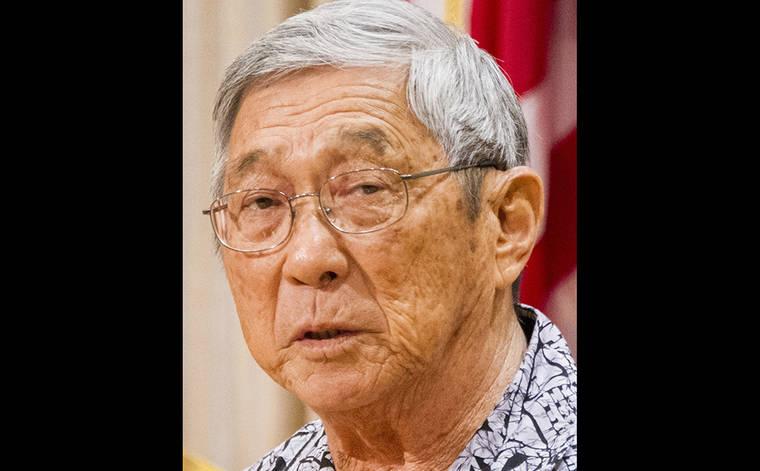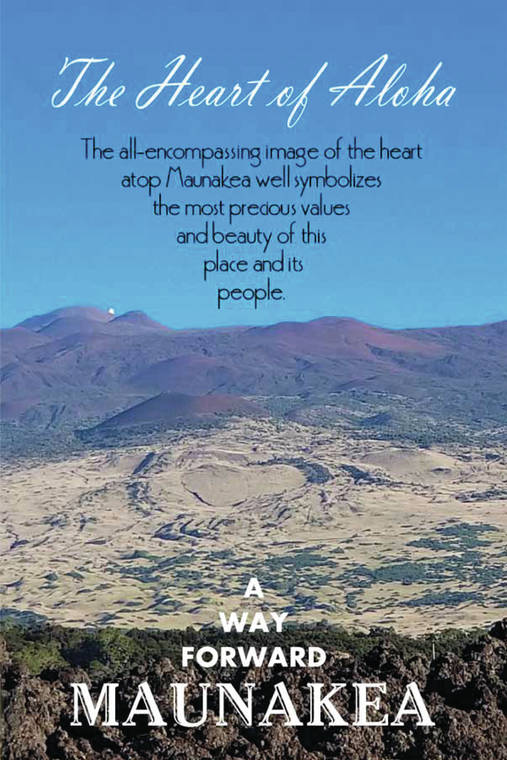Mayor Harry Kim released a proposal Monday for Maunakea that includes pledges from Gov. David Ige and other officials promising to improve Native Hawaiian relations.
The 15-page booklet, titled “Heart of Aloha — Maunakea: A Way Forward,” enumerates ways in which the state improved upon Hawaiian relations in the past 50 years and addresses specific criticisms regarding how the state and the University of Hawaii have handled management of the mountain.
The booklet was produced as the conclusion of Kim’s efforts to find common ground between supporters and opponents of the Thirty Meter Telescope, a task Ige assigned to him in July. According to the proposal, it was written as “a result of many conversations and meetings over the past years with government leaders, guardians of the mountain, community, spiritual leaders, and scientists.”
Included at the end of the proposal are pledges from Kim, Ige, UH President David Lassner, TMT Executive Director Ed Stone, Department of Hawaiian Home Lands Interim Director William Aila, and the directors of the Maunakea Observatories, each one promising to commit to improve management and stewardship of the mountain.
Ige promised to “administratively restructure the management of Maunakea to include representation by the Hawaiian community and by county government, while working with the Legislature for permanent restructuring of management,” and also committed to seek resources to increase housing on DHHL land. Aila agreed with the latter point in his own pledge.
Lassner pledged to restructure the management of the mountain, establish a Hawaiian cultural facility at Halepohaku below the Maunakea summit, set aside lands at the summit for the sole use of cultural practitioners and incorporate Hawaiian cultural education into the teaching activities at the observatories.
“You can’t imagine how much work it took to get these commitments,” Kim told the Tribune-Herald, explaining that he requested pledges in writing from each of the parties involved.
Kim said the proposal represents more than just words and is a solid demonstration of the state’s commitment to change and improve its management of the mountain and Hawaiian affairs.
Kim pointed to a Monday announcement by DHHL — wherein Aila promised to develop 1,300 more lots on Hawaiian Home Lands in the next five years, while also offering rental housing to DHHL beneficiaries — as an example of the state acting on those commitments.
Kim’s document also includes several timelines listing how the state improved upon issues of Hawaiian culture and governance, such as how Hawaiian language education has expanded since 1978.
Most of the booklet is dedicated to addressing common complaints about the TMT project and management of the mountain, and explains how the state and UH responded to those criticisms. For example, in response to the complaint that there are “too many telescopes,” the booklet references UH’s plan to decommission five of the 13 summit telescopes by 2033.
Some of the remedies listed in the booklet are quite old; the formation of the Office of Maunakea Management in 2000 is listed as the primary response to criticisms of “isolated bureaucracy.”
Kim’s proposal concludes with his vision for Maunakea, wherein the mountain is hailed as “a symbol of nations working together for the pursuit of peace and harmony.” To that end, the document proposes the creation of a cultural center on Maunakea, the establishment of strong science programs for children and adults that connect Hawaiian culture with scientific progress, and the establishment of an umbrella management authority with a strong deference to the Hawaiian community.
In response to Kim’s proposal, Doug Simons, executive director of the Canada-France-Hawaii Telescope, said in a written statement that the Maunakea Observatories are keen to contribute to Kim’s vision and “the establishment of a cultural center, melding of science and cultural views about the future of Maunakea, provision of educational programs for all ages, increasing the diversity of community based management of Maunakea, and inspiring the hope that Maunakea can be a catalyst for people of differing views to come together to forge a common vision.”
Other officials were similarly supportive Monday after reading Kim’s proposal.
Lassner wrote in a statement that Kim’s path is consistent with that of the UH Board of Regents.
“We need ideas for ways forward like these that can help shift thinking to paths in which there will be wins for all the people of Hawaii — Hawaiians and non-Hawaiians alike,” Lassner wrote. “UH stands ready to work with any and all interested in forging a peaceful way forward, whether or not they believe TMT belongs on Maunakea.”
Gordon Squires, TMT vice president of public relations, wrote that Kim’s proposal addresses several of the larger issues for which the TMT controversy has become a flashpoint and could serve as a way forward.
Cindy McMillan, Ige’s communications director, said the governor will continue to work with Kim “to achieve a better future for all.”
No official statement from the TMT protesters, who have occupied Maunakea Access Road since mid-July, was forthcoming Monday.
However, protest leader Andre Perez was skeptical.
“The title says it all, really,” Perez said. “That’s Harry Kim’s vision, not ours.”
Kim said he hopes the publication of the proposal will “open the door” for the county and state to work with the protesters toward resolving the situation.
Email Michael Brestovansky at mbrestovansky@hawaiitribune-herald.com.





